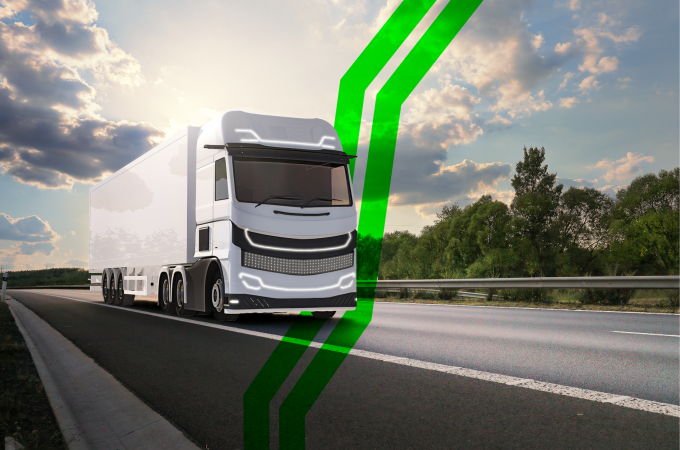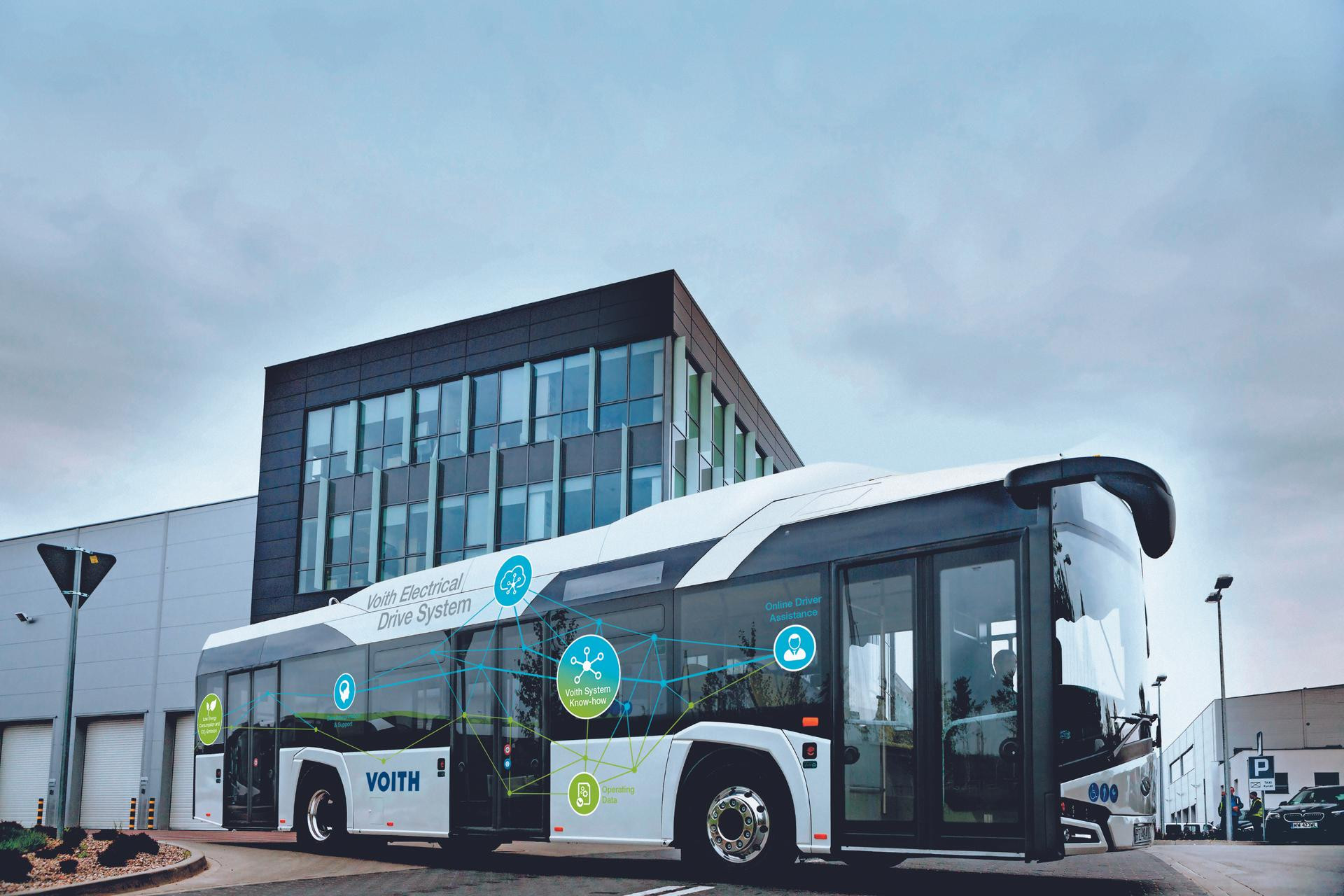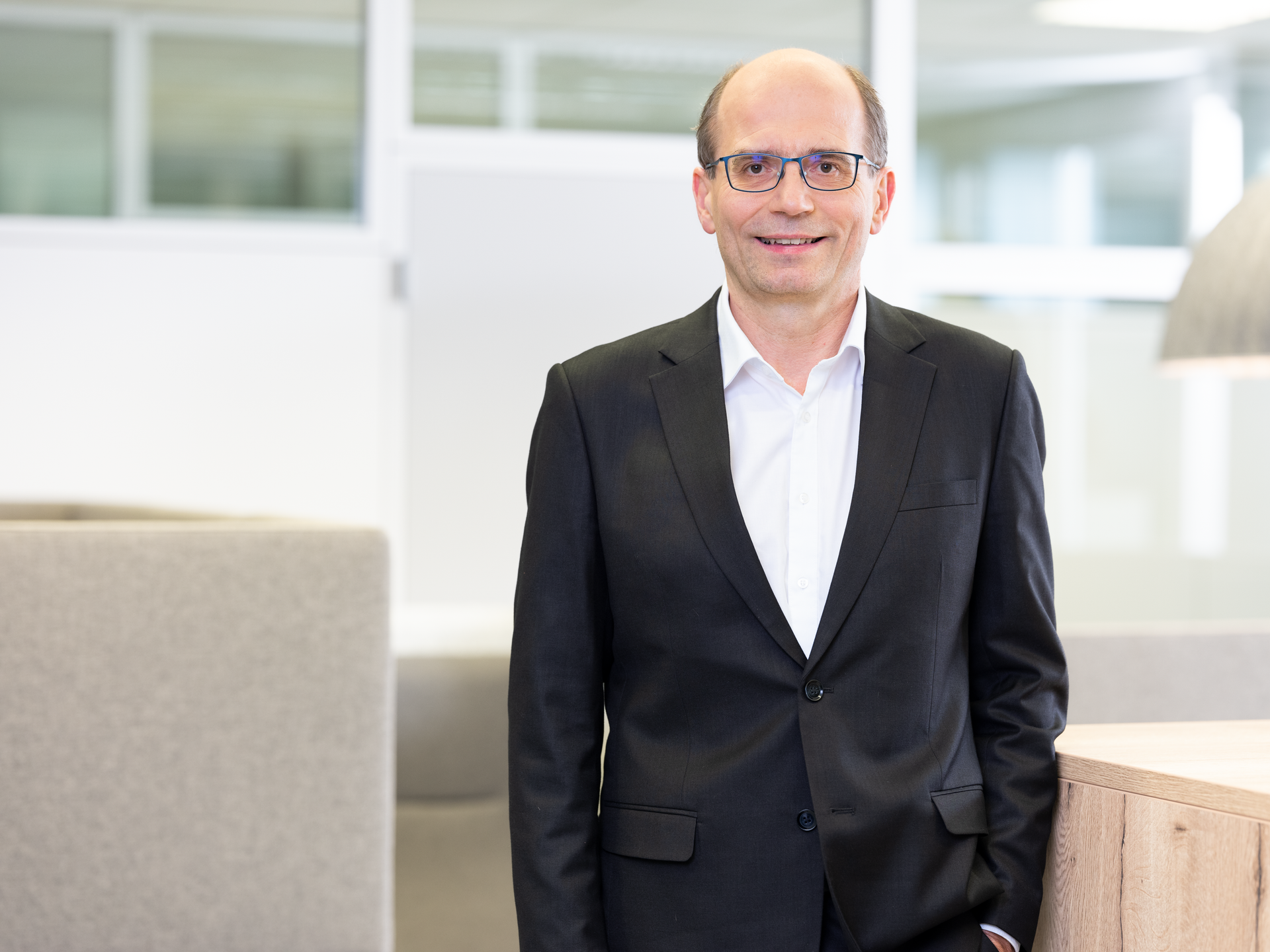Earning the right to play: an interview with Martin Wawra of Voith Turbo
By Bradley Osborne - 28th February 2023

Graphic of truck powered by VEDS HD+
It is no secret that big changes are afoot in the CV industry, and the challenges faced by manufacturers, old and new, are enormous. Martin Wawra, Head of the Mobility Division at Voith Turbo, spoke to T&BB about how the company is maintaining its “right to play” in the industry by addressing decarbonisation, digitisation, and problems such as rising costs and volatile supply chains.
Germany – 2020 was a strange year for industry. It was doubly so for the automotive sector, which faced not only the difficulties posed by the COVID-19 pandemic but also the ongoing challenge of transitioning to zero-emission vehicles. Each new year since has brought a new crisis: supply chain bottlenecks in 2021 and the Russian-led invasion of Ukraine in 2022. Many company executives undoubtedly entered 2023 with some dread as to what might come next. But the problem of decarbonisation is a very different beast compared with the others. On the one hand, businesses such as Voith Turbo are fully aware that their main product lines, which for many years have served internal combustion powertrains, could become largely redundant within the next decade. On the other hand, the market for electric powertrain components is wide open, providing opportunities for longstanding players such as Voith Turbo to capture new customers and to expand their share of the industry.
Over the course of the past half a year or so, Truck & Bus Builder has covered the newest developments in Voith Turbo’s product offering for commercial vehicles. Some of these are updates to existing product lines: for example, the ‘DIWA NXT’, a reinvention of the classic city bus transmission with a mild hybrid option for a more flexible range of applications and extra fuel savings; and the ‘Voith Electrical Drive System (VEDS) HD+’, an electric drivetrain tailored exactly to the needs of a heavy-duty truck. In the case of the ‘Plug & Drive H2 Storage System’, Voith Turbo is venturing into an entirely new market in order to respond to a growing demand for a new kind of vehicle. Behind the scenes, Voith is also reforming its customer services by bringing in new digital tools such as cloud computing and remote maintenance. When Martin Wawra recently spoke to us about Voith Turbo’s business strategy, he used these examples to emphasise the company’s strengths: namely, its adaptability to change and its diverse expertise. Wawra seems convinced that these stand Voith in good stead for overcoming the challenges of our time.
Voith’s place in the changing industry
The direction of travel for the industry is very clear, according to Wawra. In the European Union, no new petrol or diesel cars will be permitted for sale from 2035. Other legislations have passed similar restrictions. Wherever the passenger car segment goes, Wawra says, commercial vehicles will eventually follow, potentially by 2040. His experience in China has shown him that, in segments such as the city bus, change can come very rapidly. Within two years, the internal combustion engine bus was entirely pushed out of China’s major cities by the electric bus, and Wawra observes a similar trend emerging in Europe.
Naturally, the city bus has hitherto been a primary focus of Voith Turbo’s decarbonisation strategy. The VEDS product lines currently on the market have been picked up mainly by manufacturers such as Wrightbus and Alexander Dennis in the UK and Otokar in Turkey, companies who have helped to drive the change from diesel to electric in European cities.
For suburban and regional transportation, buses remain firmly grounded in internal combustion technology for the time being. As such, Voith Turbo launched its next-generation transmission, with a “mild-hybrid” option for greater fuel savings and lower emissions, to act as a “bridge technology” between present diesel and future alternative vehicles. Iveco Bus has been an early adopter of the DIWA NXT in its new ‘Crossway Low Entry Hybrid’ intercity bus. Wawra is convinced that the new transmission will “extend the lifespan” of the DIWA line as the bus segment gradually moves away from the need for mechanical gearboxes.
The truck segment is also moving to electrify, albeit more slowly. From its conversations with its major OEM customers, Voith Turbo found that, in certain heavier applications, the electric truck may still be in need of an auxiliary braking function. As such, it will be offering a retarder as an option with the VEDS HD+ for heavy-duty trucks. In the meantime, Voith Turbo is collaborating with customers to discover if its current retarders are suitable for the upcoming lines of heavy electric trucks and, if so, where they will find their applications.
When asked whether he thought the transition to electric is inevitable, Wawra expressed some doubts about long-haul trucks. Yes, they will electrify eventually, Wawra thinks, but their power source is unlikely to be large battery packs. For him, the advantages of a hydrogen-fuelled electric driveline are very convincing: fuel cell systems have a greater energy density than battery-electric ones and are lighter to boot; moreover, refuelling with hydrogen takes far less time than recharging batteries. Nevertheless, he remains unsure whether battery-electric will be the “right way” for the segment or if the industry will focus instead on hydrogen. In any case, Voith Turbo has already signalled its confidence in fuel cells by investing in hydrogen storage technology, which it showcased at the IAA in Hanover last September. Wawra is sure about the industry’s direction towards electric but he remains unsure about how it will get there.
Moreover, he is doubtful that the shift to electric would have happened so quickly in the absence of the legislations mentioned earlier. In his view, the combustion engine still has “a lot of potential”. He is also closely watching developments in carbon capture, which would involve taking CO2 emissions at source and burying it in the ground or disposing of it in some other way that does not entail polluting the atmosphere. The decarbonisation trend is driven more by politics than by economics – the conscious decision on the part of politicians and policymakers to get rid of tailpipe emissions entirely.
Just as every other business with a stake in automotives has done, Voith Turbo has had to adapt accordingly. The impact across the division’s product lines is felt unevenly, however. In some cases, Voith Turbo is simply evolving to meet changing conditions. For example, with a high-speed electric motor, Wawra says, you still need a transmission to convert the RPM to what is needed at the wheel – and so Voith Turbo’s transmission expertise will remain in demand for specific applications, with a couple of tweaks. “The revolution for us,” Wawra added, “is in the electric field.” The division’s automotive engineers have had to get to grips with components which it rarely dealt with before. Here, Voith Turbo is helped by the breadth of the company’s experience; namely, in making components for rolling stock. This has given the division expertise in inverters, for instance, which proved invaluable in the development of electric drive systems for commercial vehicles.
The fundamental challenge which Voith Turbo faces in designing and marketing its products is figuring out what product niches it ought to target in the context of significant and wide-ranging changes to the industry. The question of what automotive manufacturers will be making in the future is a live one, and a very important one, according to Wawra. The major OEMs are asking themselves, if they are to no longer make their own engines, then what will be their core product in the future? Their answers to this question will influence Voith’s direction: Voith Turbo needs to target those niche products which the OEMs won’t take it upon themselves to make on their own. Voith Turbo is well-established and knows its role as a supplier to the commercial vehicle industry, and this is something it is not looking to change.

Solaris Urbino 12 electric, powered by VEDS
Present and future challenges for Voith Turbo
The challenges faced by the automotive industry are a common refrain in press releases and company performance assessments nowadays. One which comes up repeatedly is the shortage of semiconductors. “That’s a real pain point for us,” Wawra admits. Voith Turbo could have achieved far better sales, he says, were it not for limitations to the supply of computer chips which are now an essential part in many automotive components. It is especially problematic when ramping up a new product, says Wawra.
A key priority for the Voith Group, according to Wawra, is to establish a “dual source system” for its semiconductors, and this aim is shared by others in the industry as well. To have a robust and reliable supply of chips not only from East Asia but also from somewhere else – from Europe, for example – would go some way towards reducing the volatility of the semiconductor supply chain; then, “not all eggs are in one basket”. The first steps towards European semiconductor fabrication are already being taken: Truck & Bus Builder reported only a couple of weeks ago that ZF is partnering with a semiconductor manufacturer to establish a wafer fabrication facility in Germany.1 Interruptions to the supply of key materials and components caused by the COVID-19 pandemic and the invasion of Ukraine have made people all too aware of the vulnerability of supply chains to geopolitical conditions and the negative impact they can have on everyday life. And with a component as crucial as a silicon chip – without which, computers, modern automotives, electronic consumer goods, and any other product with a digital component would be impossible to make – it is imperative that European industry secure its supply chain. This will most likely involve bringing semiconductor fabrication to Europe.
Wawra told us that, while he therefore “fully understands” why other companies are getting involved, Voith has no plans to follow suit. In any case, he expects the problems to continue for the time being, as building out a new supply chain to a significant capacity for semiconductors is costly and time-consuming. While he knows that there are “a lot” of factories being built, he assumes it will be at least two to three years before we see any relief.
More pressing, for a German company such as Voith, than any other issue is the question of energy supply. “It’s a huge challenge,” Wawra admits, as Germany reels from the effects of skyrocketing energy prices and a dwindling supply of gas from Russia. For its heavy industrial sector, which has depended for a very long time on cheap and abundant energy, the potential consequences of energy price spikes and falling supplies could be very serious. It is a major factor in the Voith Group’s rising production costs, according to Wawra. “We are analysing, how can we bring down this cost, how can we save energy?” This involves a complete rethink of how Voith makes its products. Ways to address higher energy costs might include changing what the company manufactures and what it decides to outsource, and reverting to production methods which were more expensive in the past, but which now have a cost advantage.
In this case, there is ultimately very little that Voith can do other than weather the storm. Wawra remains confident, however, that demand for commercial vehicles, and by extension Voith Turbo’s product range, will not collapse in the foreseeable future. When asked about the impact of demographic decline in Europe and China, Wawra said he is “not so worried”. While the general population might be growing older, another trend that shows no signs of abating is urbanisation. More and more people are moving to the city and are making use of urban transportation. People young and old continue to use buses, and Wawra sees no reason why this will reverse in the future.
Wawra’s predictions for the automotive sector
What will the industry look like in a decade’s time, according to Wawra? Well, first of all, there will still be plenty of combustion engines in use on the road, but these will primarily be in the Middle East, Africa, and Southeast Asia. The nature of road transportation is changing very quickly, but its impact the world over is very uneven, and in places where the infrastructure to support electric vehicles is developing very slowly (or not at all) there will still be a market for combustion engines. Nevertheless, Wawra anticipates a point in time when most OEMs will have to decide which driveline type(s) it is prepared to support. It won’t be possible for them in the long term, he believes, to keep investing money in three different kinds of vehicle – battery-electric, hydrogen, and combustion engine – and difficult choices will have to be made. Smaller companies will feel the imperative to focus on one or two types even more intensely, and Wawra points to the example of Wrightbus, which decided only in the past few years to ditch the combustion engine entirely to focus on electric drivelines.
There are many new companies which have emerged to serve the demand for electric vehicle products, as is so often the case when a new technology arrives. At the beginning, Wawra says, “everything is a blue ocean” and there is a vast number of companies chasing for market dominance; over time, however, more and more of these “will fade out” as customers flock round a few reliable suppliers who make it through the squeeze. Wawra foresees a “concentration” in the near future, as large groups use their financial heft to hoover up small companies and acquire their technologies, while other new companies will end up dropping out. The same has happened before, he says, though not at this pace.
Automotive products of the future will have a shorter lifespan, Wawra argues, not because they will be less durable, but because development cycles are much quicker. While former mechanical product lines had a shelf life of about 8-10 years, the shelf life for new electric product lines will be 3-5 years before the next generation comes up to replace them.
New ideas will come up, new technological interruptions will come up, and I think here it’s a change in mindset that’s required […] companies need to become more agile.
Wawra believes that manufacturers should respond to this new environment through closer collaboration with customers and suppliers “so that we can have this agility, and I think this is a huge issue.” He admits that all of this will make product development more expensive, and every company will need to think very carefully about where it chooses to invest its limited resources.
Wawra says that Voith is always looking for “potential growth pockets”, pockets of opportunity, for its new and existing products. Whether this means updating an established product line – such as with the DIWA NXT – or making an entirely new one – such as with the hydrogen storage system – Voith Turbo has often been able to draw upon the deep well of experience and “knowhow” in the group, which is involved in papermaking and hydropower as well as the manufacture of drive systems. There are some domains of expertise where Voith is looking to expand, such as software development, and Wawra expects the group will need more software engineers than it ever had in the past. However, in some cases, bringing in new knowledge has been merely a case of walking from one department to another. At the group level, the board of management oversees each of the three business divisions and coordinates their technical knowhow where necessary. “I think that’s really essential,” Wawra says,
and that’s the strength of the diverse group […] I think especially in these times where changes are happening, this [diversity] is a huge asset because we still have areas where we have not had this huge disruption yet, which can bring revenue streams.
Keeping upbeat in a time of unusual crises is no mean feat. Wawra is perfectly aware of the challenges ahead, but he appears unfazed by them. People in business nowadays talk up so-called “disruptors” who seek to overturn the conventions of a particular industry with a new technology or business model. And there is a lot of good in a fresh approach which is not tied down by old ways of thinking and deeply-entrenched vested interests. But there are also advantages to being part of a group which is over a hundred and fifty years old. Sometimes it pays to have been around for a long time, and Voith is prepared to use every tool it has assembled over the past centuries to maintain its “right to play” in the industry.

Martin Wawra joined the Voith Group in 1994 as an international sales engineer after studying mechanical engineering at the University of Stuttgart.
From 2001, he was Managing Director of Voith Turbo Scharfenberg GmbH & Co. KG in Salzgitter and has been part of the Voith Turbo management team.
Since 2011, he was responsible in various management positions for the successful development of production and construction in China along important growth projects. He also headed sales for the Mobility division throughout Asia.
He has been a member of the Management Board of Voith Turbo since June 2021 and heads the Mobility Division.



